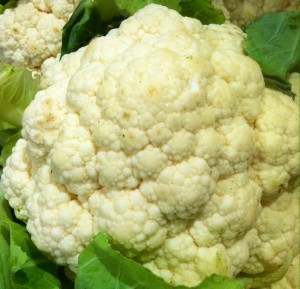September Monthly Morsels
 The Nutritional Power of Cauliflower
The Nutritional Power of Cauliflower
Kale better brace itself because there is a new “it vegetable” in town and that is cauliflower! Because of its naturally mild flavor, cauliflower is extremely versatile. It can be roasted, broiled, cooked, and steamed. It’s wonderful eaten on its own, added to soups and salads, or even manipulated into completely different forms, such as a crust for a pizza!
Cauliflower is a very nutrient dense vegetable, meaning it provides a lot of vitamin and minerals and very few calories making it a great option for the health conscious. Specifically, cauliflower is an excellent source of dietary fiber, vitamin C, K and B6, in addition to being rich in niacin, riboflavin, magnesium, phosphorus, and folate. One serving of cauliflower a day can provide more than three quarters of the daily value for vitamin C!
In addition, you may be surprised that cauliflower is high in antioxidants even though it does not contain the bright color generally associated with foods containing high antioxidant levels. (Think blueberries, beets, and broccoli). The antioxidants in cauliflower, specifically beta carotene, provide the cells in the bodies with a defense against free radicals that can wreak havoc on the body causing rapid aging and organ damage.
Cauliflower contains two phytonutrients- sulforaphane and indole-3-carbinol (I3C). These nutrients, found in all members of the cruciferous vegetable family, help prevent cancer. Sulforaphane also has been found to improve blood pressure and kidney function.
Cauliflower rates very low on the glycemic index scale meaning it doesn’t cause sharp spikes in blood sugar levels. Because it can mimic the texture of mashed potatoes after being steamed and pureed, cauliflower is the latest substitute for the homey comfort food which is usually given a bad rap partly because it has a high glycemic index.
In terms of cooking this fluffy vegetable, roasting or steaming seems to be the best routes to take. Boiling cauliflower reduces many of the beneficial phytochemicals it contains as they are lost in the water, so stick to steaming or microwaving if you’re looking for a quick cauliflower dish.
If you want to really bring out the sweetness and nuttiness of the cauliflower, try roasting as follows:
1. Remove all the outer leaves of the cauliflower.
2. Slice into large steak-like slabs and place on a flat baking sheet pan.
3. Drizzle with olive oil and sprinkle with salt and pepper or herbs of your choice.
4. Roast in a 425 degree Fahrenheit oven for 15-20 minutes.
Cauliflower seems to be popping up everywhere. Its flavors can either be highlighted and emphasized or mellowed and minimized depending on how it is made and what kind of dish it is in.
Here are two new recipes for you to try with cauliflower. Don’t forget to come back and comment. I’d love to have your feedback.
Cauliflower Parsnip Puree with Fresh pea and Feta Garnish


Leave a Reply
Want to join the discussion?Feel free to contribute!